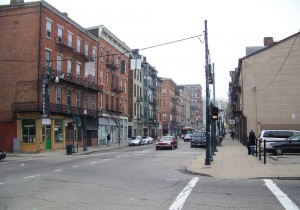(ThyBlackMan.com) Urban America, a term almost synonymous with minority and black America, is in crisis. That comes as a surprise to no one, of course. Urban life, inner-city life more particularly, is fraught with perils and starved of opportunity. Many of the themes of these crises are well known to us: high rates of crime, low rates of employment, inadequate access to healthcare, contentious relationships with police officers and governing authorities. The list goes on and on. Solutions to these crises however are not often easy to come across, so let me present a few here.
That an absence of broad-based economic opportunity is fundamental to the struggles of the urban centers of America, whether we are talking Detroit, south-side Chicago, or my own inner city Los Angeles, is hard to argue. Lack of income and financial independence is central to the instability of families and the unraveling of communities. Travel my home streets of Inglewood, Los Angeles and Watts, and in the midst of those who are making it okay, we find depressed and itinerant people struggling with an overburdened public transportation system, unkempt roads, a polluted environment and worn commercial properties serving as the ailing backbone of an economy tenuously held together by EBT.
transportation system, unkempt roads, a polluted environment and worn commercial properties serving as the ailing backbone of an economy tenuously held together by EBT.
How to fix the employment crisis? Reforming welfare and unemployment spending to couple these dollars with educational programs and occupational training that can turn the long term unemployed from frustrated recipients of government assistance to skilled and qualified students and trainees is a good place to start. Our current welfare and unemployment programs do little to provide for successful transitioning from dependence to employment.
Many people who receive unemployment remain on unemployment for a long time, and by the time their benefits are near discontinuation they find themselves seeking employment with an unattractive gap on their resumes and a lack of confidence that comes from not having participated in the workplace for an extended period. All of these things plague the inner city unemployed, making them undesirable to employers. Welfare and unemployment reform along these lines would go a long way to solving these problems.
A long way, that is, but not far enough. For while it is vital to incentivize education and training these things can only help black and inner city communities take advantage of the broader opportunities available to them. But if jobs are not prevalent in the inner cities, and they are not, than the urban population has to seek opportunity where it lies, and often it lies very far from our homes in the cities. That requires travel, and because gas is expensive and many poor blacks and Latinos do not have cars, we are left to rely on public transportation systems that are often underfunded, overcrowded, unpleasant and even dangerous.
Funding public transport systems whose routes are effectively coordinated to deliver people from the cities safely, comfortably and expeditiously to those areas where job and career opportunities are prevalent is important. This would make it more possible for the unemployed to find jobs, to actually be able to get to those jobs and to get to school and daycare as well. Ultimately, as these measures enhance urban economies these municipalities would have more tax dollars to invest in the communities as a result.
While there is not room here to give a detailed account of the inadequacies of inner city healthcare, both in terms of access and quality, as a fundamental principle it is clear to me that the more we can expand competition between providers, the more affordable care will become a reality for people everywhere, including the urban communities. One step in that direction would be to do as former President Bill Clinton and others have suggested, and allow insurance companies to compete across state lines. Certain features of President Obama’s Affordable Care Act will also help to expand access, such as mandating the coverage of people with pre-existing conditions and extending the time children are available to remain on their parent’s plans.
Other elements of the ACA however, including coverage mandates, threaten to raise costs and thereby limit access. On the local level then it is important for community groups to do what they can. (The First Ladies Health Day in Los Angeles, sponsored by Walgreens in association with a wide range of inner city churches, is bringing a diverse array of healthcare services to the urban poor in Los Angeles. It’s a great example of what the community and the business sector can accomplish when working together.)
The inner city suffers from many problems; but a healed economy is the first step in solving many of them. With the right policies in place, inner cities across America can be transformed into citadels of opportunity, empowering black America to take the reigns of its own economic future.
Written By John Randolph Wood, Jr.
Official website; http://www.blackisonline.com/

















Realman I was going to go real hard at you, but I don’t think that is the basis for productive conversation so I am going to come at you a different way.
Bro, this is what I do for a living all day everyday it is what I have multiple degrees in, a globally recognized certification in and something I think about, create models for and am now implementing in many “Black” communities.
I have helped people build and start over 200 Black businesses, and helped more than that get business loans and investments. Since you don’t know me, I hope that helps frame this conversation.
The concept of boycotting is a social justice approach, which has its place but not in this scenario, nor is it economically sound nor realistic. We arbitrarily view Koreans as an enemy because they have done what we should be doing, create a product or service for a market and use the revenue to support their family. You shouldn’t be hating on them, you should learn their methodology adopt it an do it better. The reason we BUY from them is the same reason we buy anything. Because they are serving a market need that we have at a price we are willing to pay.
When I spoke on cooperative economics for Kwanzaa his past year I made one clear point. Purchasing power does not equal economic power. Economic power is the ability to have relative control of your local domestic product within a defined geographic region.
So point 1 is to begin to create COMPETITIVE local businesses that have the capacity to acquire market share. If you don’t want Koreans in your community then out compete them. Hence the development of the network model based hair care business, which has the capacity to simultaneously bring those dollars back into the hands of Black folks, but to it with a low cost of entry for Black folks which traditionally have no capital.
Right now nationally the average Black business does approximately $14,000 in revenue and is predispositionally in a service based industry. We have very few competitive retail businesses in that space, and even fewer scaled retail businesses. Then the business to population ratio is extraordinarily low, so finding the ones that you can frequent is difficult as well. Couple that with low disposable incomes in urban core areas, and the inability to for small retail shops to create economies of scale which correspondingly push up local price points relative to their non-Black competitors and you have a challenging mix. Innovation around this scenario is key.
I am from the Marcus Garvey school of thought. Marcus Garvey preached that our greatness will come from our ability to create excellence around economic, political, moral and scientific systems and knowledge. Our goal is to create systems that shift our paradigm first and then our economy second with the major ambition of creating competitive Black power. This isn’t civil rights, boycott at any slight stuff.
Bro, name me one major Black hair care retailer in your community that has the scale and price points of a Korean hair care retailer? Now, tell me if that same Black retailer is in the majority of Black communities across the nation? Replicate that same question around every industry that you know that is in the Black community.
Now move to “retail” and move to wholesale and manufacturing AKA the whole supply chain, areas in which Black business on a national scale are virtually non-existent.
It is not ‘simple’ as you suggest, but it is doable and I know this because this is what I do. It is not doable if you take a reactionary approach. But if you take an economic development approach, with Black power through Black competitiveness it can and will happen. In our lifetime.
@ Vessay
You seem to have a strange and bizarre way viewing the black community. You basically encourage blacks to support nonblack businesses and not their own. The title of this article specifically states “Reviving the Inner-City Economy”, probably 98% of the business owners in the black community or Inner City are not black owned. Once these business owners make a profit that money is not recycled back into the black community and these are business that only hires people who look like the owners. Please tell me how many of these Koreans, Arabs, etc. who profit off the black community actually give back or supports worthy causes in the communities where they reap the profits and benefits from? It’s no surprise to me that you are the one saying this.
Good concept for an article. The challenge is that there is economic opportunity and lots of it, in our inner-cities, the challenge is that we haven’t developed the capacity to capture it and generate collective wealth from it.
Realman, Black’s haven’t failed their own communities, well, I guess they have if you take a very narrow view of it. Economics isn’t a mutually exclusive, zero-sum game. It is a serious of market based relationships both internally and externally with other groups. Our particular challenge, based upon our history, is that we haven’t been able to make the transition from social justice / civil rights to economic empowerment.
There is a reason for that as well though. We have relied on industrialized education and the “education to get a job” concept to much. In addition, we haven’t been able to leverage our collective income into local wealth and the recycling of dollars.
Boycotting Korean hair care is ludicrous. If we boycotted every non-Black product then we would be naked. What we need to do is bring innovation back first to our children in our schools, daycares, churches, and then train them to take innovation and introduce it to the market, which is the basis for entrepreneurship.
For example, one of the things I have on my short term bucket list is the creation of a network marketing based Black hair care product company.
Any other thing about boycotting other businesses, is we tend to focus on the retail side. So even if we boycott them in favor of our own, what about the distributors and manufactures? 99% chance that they won’t be Black either. We going to boycott them too.
So we must compete, compete, compete. But we can.
Blacks have failed their own communities. Much of the economic blight that occurs could be corrected easily by having black consumers to boycott all nonblack beauty and hair salons, liquor stores and other nonblack businesses. Encourage black residents to patronize black owned businesses and get guarantees from black business owners to provided excellent services. Also hire black own black security firms to patrol these areas while working in conjunction with the local police since legal economic growth is impossible in crime ridden areas. It’s all quit simple.